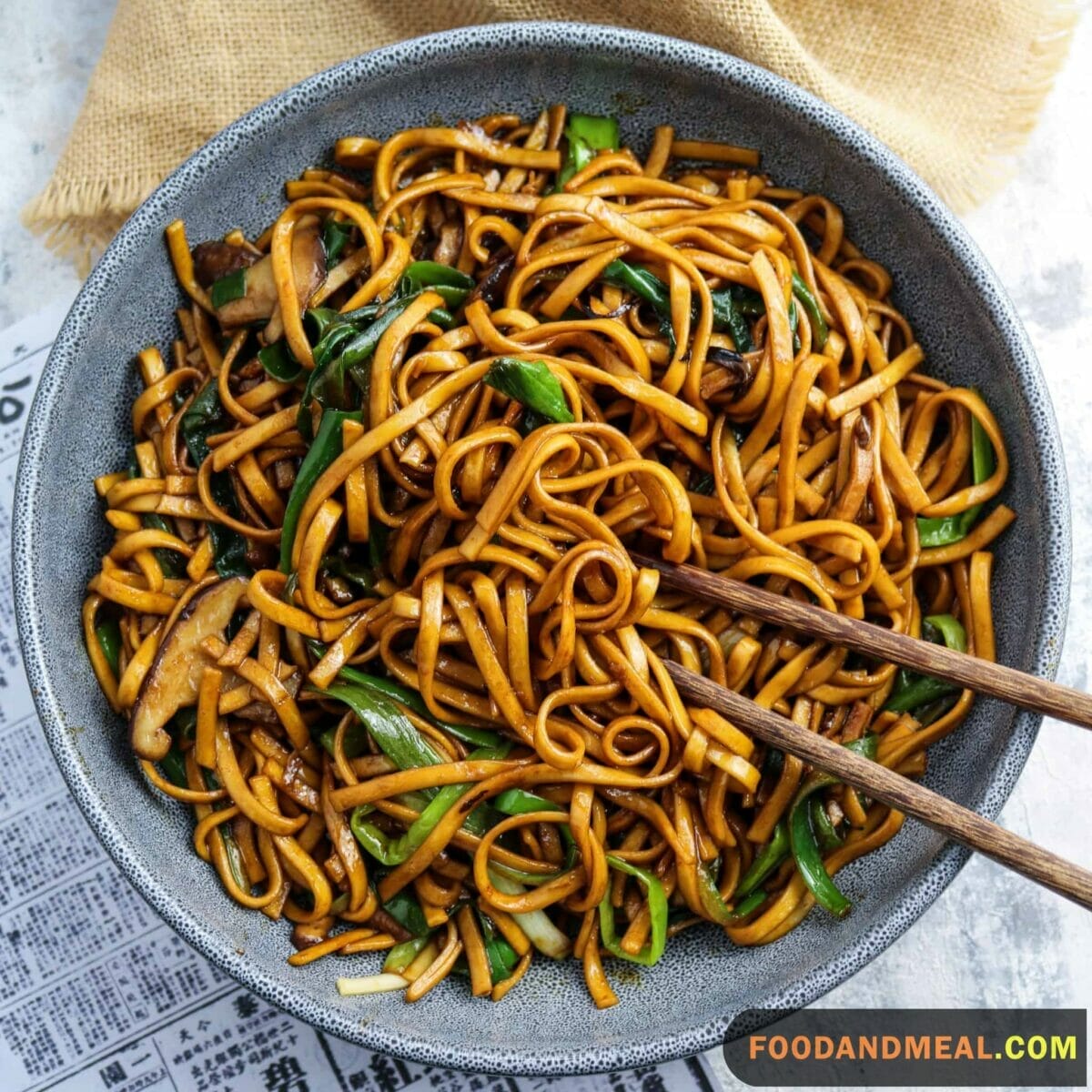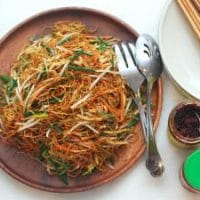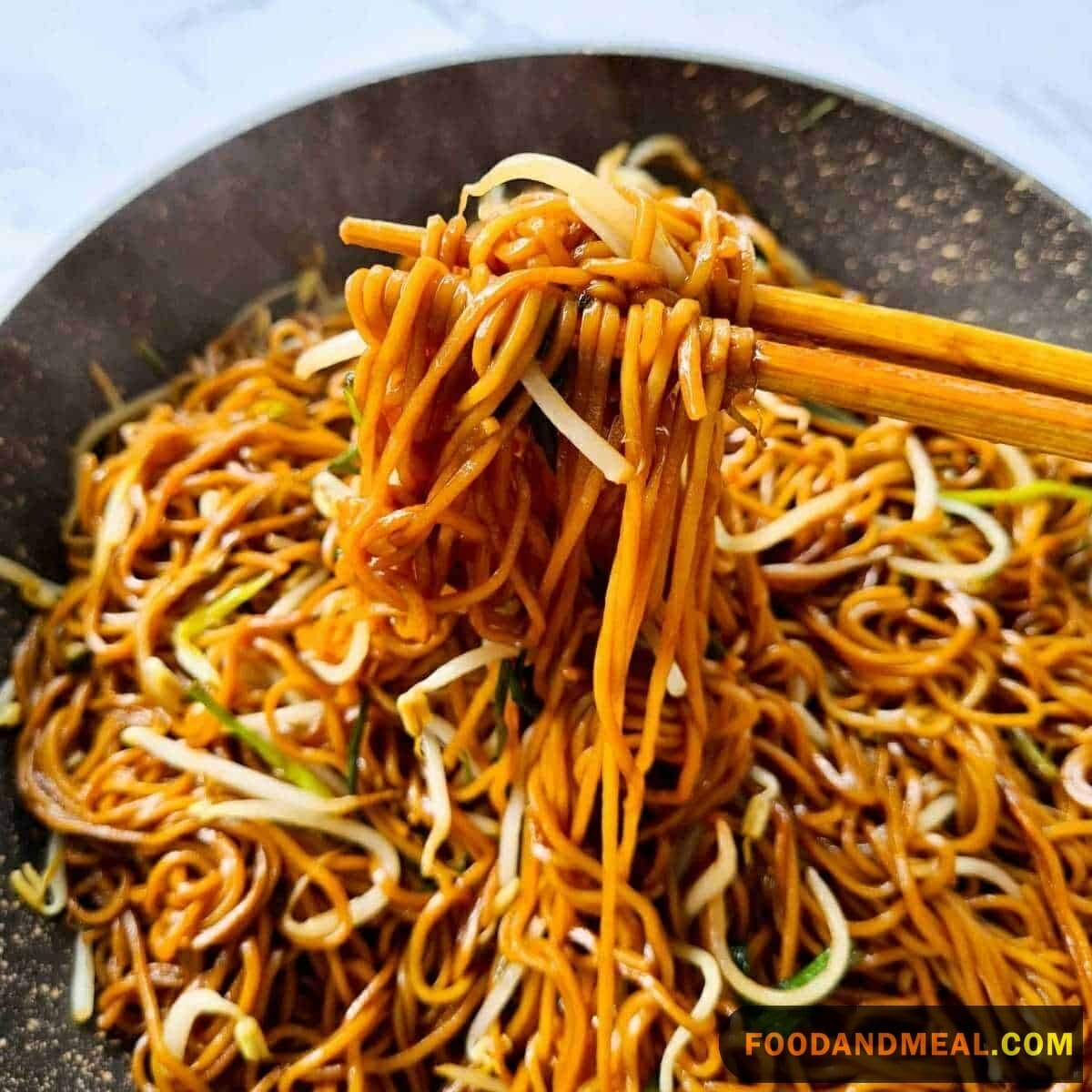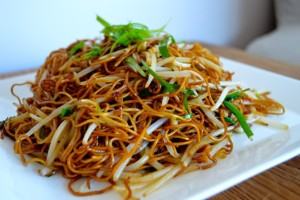Welcome to the world of Chinese Noodles, where every strand is a delicious journey to Asia. As a seasoned food blogger and chef, I’m thrilled to share this exceptional recipe that brings the flavors of Chinese cuisine right to your home. Whether you’re a noodle enthusiast or just looking to try something new, these Chinese Noodles will not disappoint. Let’s embark on this culinary adventure together!
Chinese Noodles Recipe


Chinese Noodles or Regular Pasta with Soy Sauce
Instructions
- Pour water into a pot and put over a high flame. Cook the noodles or pasta as per instruction which can be read at the back of the packaging.
- Temper the soy sauce with water, observing a 1:1 ratio and set aside.
- Get your skillet and put over a medium-high heat, and then pour a small amount of oil. Quickly stir-fry the carrots, zucchini, onions, garlic, ginger and bell pepper. Cook them until they are tender but still crunchy.
- If you haven’t drained your pasta yet, do so and transfer into the skillet. If you have left over cooked meat like chicken or beef, shred it and put with vegetables.
- Pour the tempered soy sauce into the skillet. In one pound of noodles or pasta, you must put 1/3 cup of soy sauce. Toss the pasta, vegetables and meat in soy sauce and make sure everything is evenly coated and cooked.
- Transfer everything in a platter and top it with crushed peanuts, stir-fried bean sprouts and scallions.
- How to Cook Chinese Noodles

Video
Notes
Nutrition
© Food And Meal
This website provides approximate nutrition information for convenience and as a courtesy only. Nutrition data is gathered primarily from the Spoonacular Database, whenever available, or otherwise other online calculators.
Alternative Method: Steamed Chinese Noodles

Ingredients:
- 200g of Chinese noodles
- Water for steaming
- A steaming basket or bamboo steamer
- A pot or wok with a lid
Instructions:
- Prepare the Noodles:
- Start by cooking the Chinese noodles as you normally would—by boiling them in water. This initial step ensures they are partially cooked.
- Steam Setup:
- Fill a pot or wok with water, but don’t let the water touch the bottom of your steaming basket or bamboo steamer when it’s placed inside. You want to create a steaming environment.
- Steam the Noodles:
- Place the partially cooked Chinese noodles into the steaming basket or bamboo steamer, ensuring they are spread out evenly to allow steam to circulate. Cover the steaming basket with a lid.
- Steaming Process:
- Bring the water in the pot or wok to a gentle boil over medium heat. Once the steam starts to rise, you can begin the steaming process.
- Steam the noodles for approximately 10-15 minutes. The exact time may vary depending on the thickness of the noodles.
- Check for doneness by tasting a strand of noodle. They should be soft and slightly chewy.
- Serve:
- Once the noodles are done, carefully remove them from the steaming basket. You can drizzle a little sesame oil or soy sauce for added flavor.
- Serve your steamed Chinese noodles with your favorite stir-fried vegetables, protein, or sauce. This method works perfectly for creating healthy, light, and flavorful noodle dishes.
Tips for making Chinese noodles

Cooking Tips
- Choose the Right Noodles: When buying Chinese noodles, look for fresh or dried ones depending on your recipe. Fresh noodles are ideal for quick meals, while dried ones work well for stir-fries and soups.
- Boil Adequately: Whether you’re boiling or steaming the noodles, cook them to ‘al dente,’ which means they should be soft but still slightly chewy. Overcooked noodles can become mushy and less flavorful.
- Rinse and Drain: After boiling, rinse the noodles with cold water to stop the cooking process. Make sure to drain them thoroughly. A little drizzle of oil can prevent them from sticking together.
- Don’t Overcrowd the Pot: If you’re boiling noodles, ensure there’s enough water and space in the pot. Overcrowding can lead to uneven cooking.
- Use High Heat for Stir-Fries: When using Chinese noodles in stir-fries, make sure your wok or pan is hot. High heat ensures that noodles don’t turn soggy and retain a delightful chewiness.
- Marinate for Flavor: Marinating noodles before stir-frying or adding a flavorful sauce can elevate the taste. Consider marinating them with soy sauce, sesame oil, and your preferred seasonings.
- Avoid Overcooking in Soups: If you’re adding noodles to soup, cook them in the soup broth itself for the last few minutes. Overcooking can result in an unappetizing texture.
Serving Suggestions

- Sides: Serve your Chinese noodles with a side of steamed or stir-fried vegetables for a balanced meal. Broccoli, bok choy, or snap peas work exceptionally well.
- Garnishes: Add a burst of freshness with garnishes like chopped green onions, cilantro, or bean sprouts. A sprinkle of toasted sesame seeds or crushed peanuts can also add delightful texture.
- Protein: Customize your noodle dish by adding your choice of protein. Sliced chicken, shrimp, tofu, or thinly-sliced beef are all great options.
- Beverages: Pair your noodles with a cold, refreshing beverage like iced tea, or a hot cup of green tea. A light, crisp white wine can also complement the flavors well.
- Different Serving Styles: Try your Chinese noodles in a variety of serving styles – from classic noodle soups to savory stir-fries. You can also enjoy cold noodle salads during hot summer days.
Frequently Asked Questions about Chinese noodles

- Can I prepare Chinese noodles in advance and store them? Yes, you can make Chinese noodles in advance. Cook and rinse them, toss them in a little oil to prevent sticking, and store in an airtight container in the refrigerator for up to three days.
- How can I reheat Chinese noodles without them turning soggy? To reheat Chinese noodles, bring water to a boil and then submerge the noodles for a few seconds until they loosen. Drain and use as desired. For stir-fries, add the noodles directly to your hot pan.
- Are Chinese noodles gluten-free? Most Chinese noodles are made from wheat flour and are not gluten-free. However, you can find gluten-free versions made from rice, sweet potato, or other alternative flours.
- What’s the difference between lo mein and chow mein? The primary difference is in the noodles used. Lo mein features soft, boiled noodles, while chow mein uses crispy, fried noodles. They also vary in regional Chinese cuisine.
- Can I use Chinese noodles in non-Chinese dishes? Absolutely! Chinese noodles are incredibly versatile. You can incorporate them into various international cuisines, such as Thai, Vietnamese, or Japanese dishes.
Master the art of making Chinese noodles at home. Explore our recipe and expert tips. Subscribe for more culinary delights.
Experience the culinary brilliance of Chef John at Food And Meal Restaurant. With over 20 years of global expertise, My innovative creations and unwavering dedication to cooking have earned me a well-deserved reputation. My passion for gastronomy is showcased in every dish, combining fresh, local ingredients with harmonious flavors and captivating presentations. My ability to tell a story through my food reflects my profound understanding of culture and emotion.



